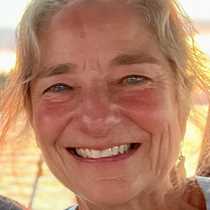Iyoukeen Inlet
When breakfast was announced this morning, we realized that eating on this voyage is optional. How could we retreat to the dining room when fourteen humpback whales were feeding in front of us?! We listened to their eerie feeding calls, watched their circular bubble nets appear, then saw more than a dozen, forty-ton whales blast to the surface, mouths open ... it was fantastic and mesmerizing.
We aren’t here to eat; the whales are.
Humpback whales fast for most of the year, living off fat built up during their summer feeding season. While they are in the rich, productive waters of Alaska, they feed for much of the day. Over the summer, an adult humpback whale might gain 13 tons, about one-third of its weight. This population winters in Hawaiian waters, where they mate and give birth, but do not eat. When they arrive in southeast Alaska in the spring, they are noticeably thinner.
This morning was not a good time to be a herring. As the group of whales surfaced within the circular nets of bubbles, their mouths were open. Some whales were on their sides, some lunged far out of the water, and 15-foot long pectoral flippers came high out of the water, too. I imagine that for thousands of herring trying to avoid huge flippers, bubble nets and cavernous mouths, it must have felt like being in a giant eggbeater.
At 0630 this morning, not only were there cooperatively feeding humpback whales near the ship, but killer whales as well. The orcas swam on, but the humpbacks continued feeding for several hours, slowly making their way north from Iyoukeen Inlet. At times they were feeding just feet off the rocky shore. A young whale appeared to ‘stand on its head’ nearby. Was this a young calf left on its own while its mother was busy feeding? The large group split in half. We listened to their feeding calls with the hydrophone; at times we heard two different whales vocalizing. The whale watching paparazzi on Sea Bird’s bow snapped thousands of photos whenever the whales surfaced.
We returned to Iyoukeen Inlet to kayak and explore the forest. Large spruce trees grew near a creek, and stumps of trees that had been cut long ago were as soft as mulch. Mosses covered nearly every surface of the forest.
After dinner, the unthinkable occurred. More killer whales! We followed them in the waning light as they swam south in Chatham Strait.
When breakfast was announced this morning, we realized that eating on this voyage is optional. How could we retreat to the dining room when fourteen humpback whales were feeding in front of us?! We listened to their eerie feeding calls, watched their circular bubble nets appear, then saw more than a dozen, forty-ton whales blast to the surface, mouths open ... it was fantastic and mesmerizing.
We aren’t here to eat; the whales are.
Humpback whales fast for most of the year, living off fat built up during their summer feeding season. While they are in the rich, productive waters of Alaska, they feed for much of the day. Over the summer, an adult humpback whale might gain 13 tons, about one-third of its weight. This population winters in Hawaiian waters, where they mate and give birth, but do not eat. When they arrive in southeast Alaska in the spring, they are noticeably thinner.
This morning was not a good time to be a herring. As the group of whales surfaced within the circular nets of bubbles, their mouths were open. Some whales were on their sides, some lunged far out of the water, and 15-foot long pectoral flippers came high out of the water, too. I imagine that for thousands of herring trying to avoid huge flippers, bubble nets and cavernous mouths, it must have felt like being in a giant eggbeater.
At 0630 this morning, not only were there cooperatively feeding humpback whales near the ship, but killer whales as well. The orcas swam on, but the humpbacks continued feeding for several hours, slowly making their way north from Iyoukeen Inlet. At times they were feeding just feet off the rocky shore. A young whale appeared to ‘stand on its head’ nearby. Was this a young calf left on its own while its mother was busy feeding? The large group split in half. We listened to their feeding calls with the hydrophone; at times we heard two different whales vocalizing. The whale watching paparazzi on Sea Bird’s bow snapped thousands of photos whenever the whales surfaced.
We returned to Iyoukeen Inlet to kayak and explore the forest. Large spruce trees grew near a creek, and stumps of trees that had been cut long ago were as soft as mulch. Mosses covered nearly every surface of the forest.
After dinner, the unthinkable occurred. More killer whales! We followed them in the waning light as they swam south in Chatham Strait.




